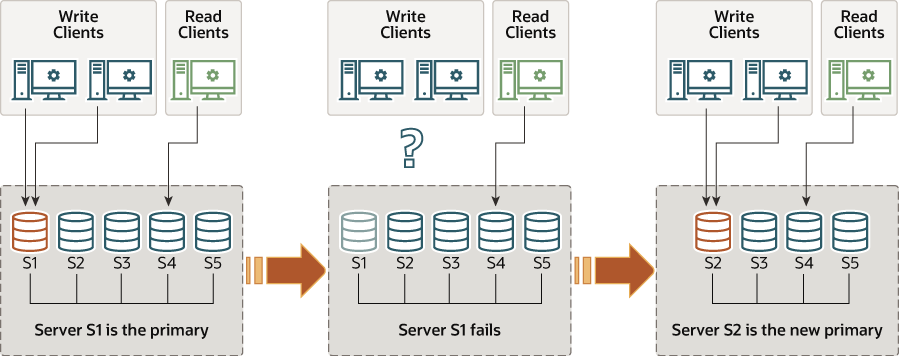In this mode the group has a single-primary server that is set
to read-write mode. All the other members in the group are set
to read-only mode (with
super-read-only=ON
). This happens automatically. The primary is typically the
first server to bootstrap the group, all other servers that join
automatically learn about the primary server and are set to read
only.
When in single-primary mode, some of the checks deployed in
multi-primary mode are disabled, because the system enforces
that only a single server writes to the group. For example,
changes to tables that have cascading foreign keys are allowed,
whereas in multi-primary mode they are not. Upon primary member
failure, an automatic primary election mechanism chooses the new
primary member. The election process is performed by looking at
the new view, and ordering the potential new primaries based on
the value of
group_replication_member_weight.
Assuming the group is operating with all members running the
same MySQL version, then the member with the highest value for
group_replication_member_weight
is elected as the new primary. In the event that multiple
servers have the same
group_replication_member_weight,
the servers are then prioritized based on their
server_uuid in lexicographical
order and by picking the first one. Once a new primary is
elected, it is automatically set to read-write and the other
secondaries remain as secondaries, and as such, read-only.
When a new primary is elected, it is only writable once it has processed all of the transactions that came from the old primary. This avoids possible concurrency issues between old transactions from the old primary and the new ones being executed on this member. It is a good practice to wait for the new primary to apply its replication related relay-log before re-routing client applications to it.
If the group is operating with members that are running
different versions of MySQL then the election process can be
impacted. For example, if any member does not support
group_replication_member_weight,
then the primary is chosen based on
server_uuid order from the
members of the lower major version. Alternatively, if all
members running different MySQL versions do support
group_replication_member_weight,
the primary is chosen based on
group_replication_member_weight
from the members of the lower major version.
